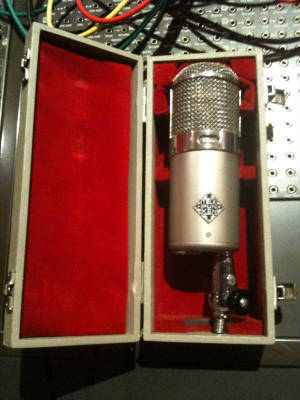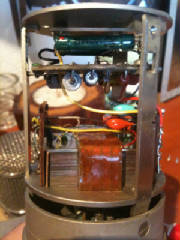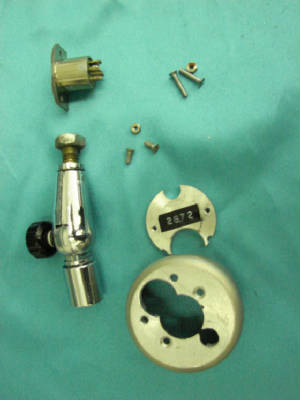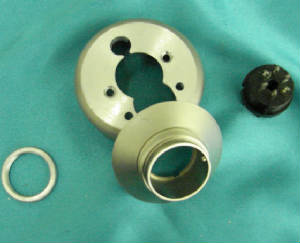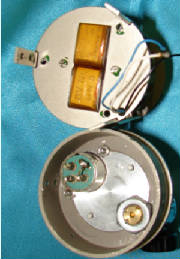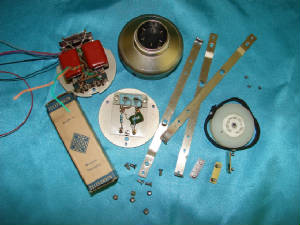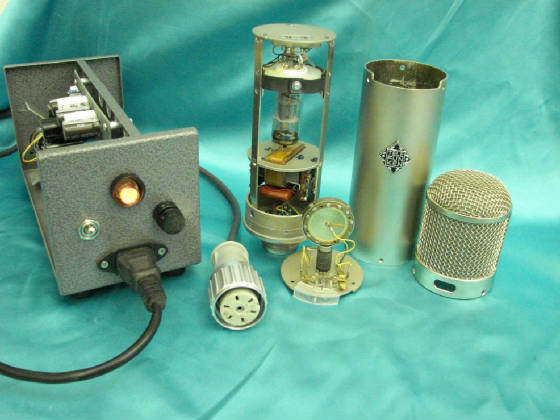U47 Rebuild
Recently, I had the opportunity to chat with producer Tom Tatman of Catamount Recording in Cedar Falls, Iowa. He had recently purchased a UM57 off of ebay that I had modified a couple of years ago. He was so happy with his UM57 that he asked me if I would be willing to help him find a good U47 for his studio and I agreed. We started looking at candidates and then I remembered a recent thread on PSW about a U47 Fet conversion mic that was offered on ebay.
The mic looked like a home made Fet conversion where someone chopped the mic in half. At first glance, it seemed that it was pretty much all the way gone with no hope other than for salvage parts. But after closer examination, it seemed that only the three support ribs, the body tube and the bottom bell would need to be replaced. I suggested to Tom that if he could get the mic for the "right price" we would be able to fix it for him and he would not only have a great sounding mic but save money in the end as well.
After exchanging a few e-mails with the seller, I was convinced that the he was legitimate and honest about his descriptions. However, many times when you bid on an international e-bay auctions it is like placing a red/black bet on the roulette table... I pointed out the risk to the buyer and told him that it could be a good way to get a hold of a great recording mic without spending $8-15K. Tom decided to go for it, won the auction within the pricing parameters that we gave him and he had the U47 within three days of the end of the auction. A day later it showed up here in Gaylord and to my surprise, the capsule was in great shape and sounded stellar. There was some minor dust particles on the capsule, but it was still able to pass the breathing test so we were able to use it in the final microphone.
It took about 20 min to take the mic apart to check the status on all original parts and fortunately, just like the capsule, all of the components were in great shape. The bottom bell
was quite damaged; sawed down and then filed flush. An aluminum plate had been installed so the big hole, where once the Tuchel connector was could be covered and a relatively heavy swivel mount had been secured with a nut inside the bottom bell. The Switchcraft connector was filed to size and overall while the modification job was rough, they had done a sturdy job. My original plan was to use a male Tuchel chassis mount like the very first 47 used, but the cut was done too close to the inside bottom so the chassis mount would not have looked right. After planing the bottom bell on a lathe there was enough original material left to attach a new bottom bell that was reduced from the opposite end so that we could keep the original serial number with the bell. After two hours of fine turning the matching part, it was attached with four 4-40 screws. To seal the hairline gap, the bottom bell was vacuum coated with an epoxy filling agent, that was later smoothed using steel wool, leaving just enough inside the gap to close it.
The transformer deck was flipped around and the side-mounted, hardpaper eyelet boards that hold all vital resistors and capacitors had been reused with different components for the 48V buffering and filtering stage. No problem to remove them and reload them with Metal film 1% resistors and metalized film caps. While some would argue about the minute differences other type of caps like Polypropylene or Oil-filled caps might achieve, you can make similar sound changes just by moving the mic into a different spot...
In the auction pictures as well as all additional pics provided by the seller, the model number of the transformer was not visible. After taking the mic apart, I discovered a nearly mint condition transformer; a GN8(b) transformer. This was a later BV8 revision with a built-in low cut filter, starting at 100Hz. It is quite easy to get rid of the low end cut filter but if the
transformer shows any age related deterioration (like crumbling wire) any attempt to remove the filter ends would result in the destruction of the transformer and it would then need to be rewound. Fortunately, the transformer was in great shape and I was able to remove the filter quite easily.
The next step was to install the new support ribs. The original ones were cut in half and since they were made from sheet brass it would be almost impossible to enlarge them. We replaced them with a new set of steel support ribs that were nickel plated to prevent corrosion. While installing them a filament dropping resistor was also installed to insure that the mic would heat up to the proper temperature like a historic U47. Nickel is quite sensitive to temperature and the heater dropping resistor warms up the body, thermally biasing not just the transformer but all components. Inside VF14 operated U47's the temperature is in average between 55 and 65 degrees Centigrade, enough to push the transformer as well as the caps into a different state of sound compared to room temperature.
The biggest question of course was what to do about the missing VF14 tube? This was probably the reason why the mic was converted to a Fet circuit in the first place. Only 27,500 VF14 tubes were ever made by the original Telefunken company in Germany and they stopped production in 1958. Only about 1/3 of the VF14's passed the rigorous standards for being considered microphone grade so with about 9000 tubes and approx. 5500 U47/U48 mics made there are virtually no spare tubes left. For the longest time, there was just the Neumann NuVistor mod, but since the U47 regained popularity there are a bunch of "drop-in" replacements. The first thought was the Telefunken VF14K replacement, but unfortunately they do not sell them to the public.
Saturn Sounds Missing Link and Andreas Grosser’s transistor VF14 replacement were also options, but since the mic needed a complete rebuild anyway we decided on a glass tube replacement that runs off 14V. Aside from the different package and filament the tube sounds nearly identical to a good working VF14 and uses a similar dropping resistor that also provides the heat that we need to raise the inside temperature of the microphone to bias the internal components like a VF14 run U47. While we rebuilt the mic with a glass tube the ability to convert back to a VF14M is quite easy in case some become available at a later date. Instead of a Stahlroehren socket we created a nylon disc that has the same diameter as the VF14 socket and houses a ceramic Noval socket instead. A nice side effect of the glass tube mod is that there is less noise and microphonics. There was some original wire left over but to insure that the mic would be reliable for a long time, the mic was rewired with stranded silver plated copper with Teflon sleeve.
The next big challenge was to decide which connectors to use. The original Tuchel connectors are no longer made and although there are some aftermarket ones being made, they are no comparison to the original Tuchels. Scouting ebay.de is the best way to get a hold of used original Tuchel connectors. Fortunately, these connectors were also used for other audio devices such as speakers and measuring equipment, otherwise there would be no inventory left to use. For the female cable end to the mic an original Tuchel was used while the male end of the cable to the PSU a Binder 7-pin connector was used. This is the same type of connector used by Neumann for their M2xx mics. It is not historically correct for the U47 but it gets the job done for a fraction of the cost. Also remember that this mic did not come with the original PSU and our AMI replacement power supply that was used features the Binder series female chassis mount connector. Our PSU is a modern reworking of the late 60’s style Neumann PSU
used for the M49 mics, but without the pattern control and can easily be converted to the NG style PSU in case a VF14 tube is found at a later date. For the cable we used Gotham GAC-7 but an interesting alternative is the AccuSound CX-7 modeled after the old EMT cable that was built to the specifications of the IRT and used in broadcast applications throughout Europe.
After everything is said and done the mic turned out quite beautifully! The mic is nearly as good as new and with the BV8 and the K47 in great condition, Tom and the folks at Catamount Recording should have no problem with that mic for many years to come. For the replacement/missing metal parts we used some of the parts out of our recently introduced U47 kit and the NOS Telefunken tube is still easy to find. With all of the work described it only took a weekend to repair the mic.
Also Read:

